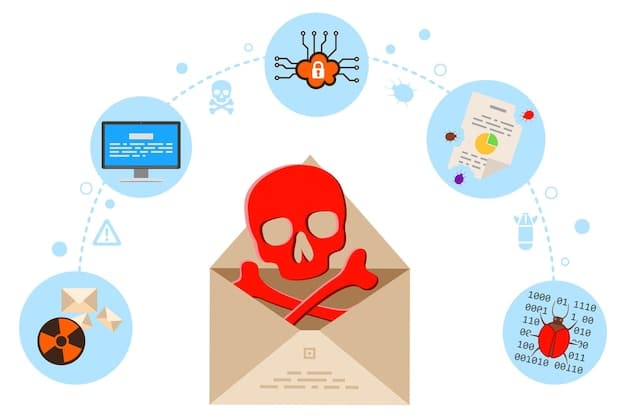Cybersecurity Training: Protecting Your Company in 2025

Cybersecurity training for employees is crucial in 2025 as it equips them with the knowledge and skills to identify and prevent cyber threats, safeguarding sensitive data and ensuring business continuity.
In 2025, the digital landscape is fraught with increasingly sophisticated cyber threats. Investing in cybersecurity training for employees is no longer optional but a critical necessity to protect your organization from potential breaches and data loss.
Why Cybersecurity Training is Non-Negotiable in 2025
The threat landscape is evolving at an alarming rate, with cybercriminals constantly developing new and more sophisticated attack methods. Traditional security measures are no longer sufficient to protect against these threats. A well-trained workforce acts as a critical first line of defense, capable of identifying and mitigating potential risks.
The Rising Cost of Cybercrime
Cybercrime is a lucrative business, and the costs associated with data breaches and cyberattacks are staggering. These costs include not only financial losses but also reputational damage, legal fees, and regulatory fines. Investing in cybersecurity training is a proactive measure that can significantly reduce the risk of becoming a victim of cybercrime.
Human Error: The Weakest Link
Studies have shown that human error is a major contributing factor to data breaches. Employees who lack adequate cybersecurity training are more likely to fall victim to phishing scams, use weak passwords, or inadvertently expose sensitive data. By providing employees with the knowledge and skills they need to identify and avoid these pitfalls, you can strengthen your organization’s overall security posture.
- Reduced risk of data breaches and cyberattacks.
- Improved employee awareness of cybersecurity threats.
- Strengthened overall security posture.
- Compliance with industry regulations.
In conclusion, cybersecurity training is no longer a luxury but a necessity for organizations of all sizes. By investing in employee training, you can significantly reduce your risk of becoming a victim of cybercrime and protect your valuable assets.
Evolving Cyber Threats: What Employees Need to Know
Cyber threats are constantly evolving, and employees need to stay up-to-date on the latest attack methods and prevention techniques. Training programs should cover a wide range of topics, including phishing scams, malware attacks, social engineering, and password security.

Phishing Awareness
Phishing scams are one of the most common and effective methods used by cybercriminals to steal sensitive information. Employees need to be able to identify phishing emails and understand how to avoid becoming a victim. Training should include examples of phishing emails, tips for spotting red flags, and instructions on how to report suspicious emails.
Password Security Best Practices
Weak passwords are a major security vulnerability. Employees should be trained on how to create strong, unique passwords and how to protect their passwords from being compromised. Training should also cover the importance of using multi-factor authentication whenever possible.
- Phishing scams and how to identify them.
- Malware attacks and how to prevent them.
- Social engineering tactics and how to avoid falling victim.
- Password security best practices.
In summary, staying informed about evolving cyber threats is crucial for employees to effectively protect themselves and the organization. Regular training and updates are essential to maintain a strong security posture.
Building a Comprehensive Cybersecurity Training Program
A comprehensive cybersecurity training program should be designed to meet the specific needs of your organization. The program should be engaging, interactive, and relevant to employees’ day-to-day activities. It should also be regularly updated to reflect the latest cyber threats and best practices.
Assessment and Needs Analysis
Before developing a training program, it’s important to assess your organization’s current security posture and identify any gaps in employee knowledge. This can be done through surveys, quizzes, and simulated phishing attacks. The results of the assessment will help you tailor the training program to meet your specific needs.
Interactive Training Methods
Interactive training methods, such as simulations, games, and case studies, are more effective than traditional lecture-based training. These methods allow employees to actively participate in the learning process and apply their knowledge in a realistic setting.

By incorporating interactive elements into your training program, you can increase employee engagement and improve knowledge retention.
A comprehensive cybersecurity training program should include:
- Regular training sessions and updates.
- Interactive training methods, such as simulations and games.
- Real-world examples and case studies.
- Ongoing assessment and feedback.
In conclusion, a well-designed cybersecurity training program is essential for creating a security-conscious culture within your organization.
Measuring the Effectiveness of Cybersecurity Training
It’s important to measure the effectiveness of your cybersecurity training program to ensure that it’s achieving its intended goals. This can be done through a variety of methods, including quizzes, surveys, and simulated phishing attacks. The results of these assessments can be used to identify areas for improvement and to track progress over time.
Pre- and Post-Training Assessments
Conducting pre- and post-training assessments can help you measure the knowledge gained by employees as a result of the training program. These assessments should be designed to test employees’ understanding of key cybersecurity concepts and their ability to apply this knowledge in real-world situations.
Simulated Phishing Attacks
Simulated phishing attacks are a valuable tool for assessing employees’ ability to identify and avoid phishing scams. These attacks should be realistic and challenging, but not so difficult that they discourage employees. The results of these attacks can be used to identify employees who need additional training and to track the overall effectiveness of the training program.
Key metrics to track include:
- Employee knowledge and awareness of cybersecurity threats.
- The rate of successful phishing attacks.
- Employee compliance with security policies and procedures.
- The number of reported security incidents.
In summary, measuring the effectiveness of cybersecurity training is crucial for ensuring that it’s achieving its intended goals and protecting your organization from cyber threats.
The Role of Leadership in Promoting Cybersecurity Awareness
Leadership plays a critical role in promoting cybersecurity awareness and creating a security-conscious culture within the organization. When leaders prioritize cybersecurity and actively participate in training programs, it sends a strong message to employees that security is a top priority.
Setting the Tone from the Top
Leaders should communicate to employees the importance of cybersecurity and the role that each individual plays in protecting the organization. They can do this through internal communications, town hall meetings, and other forums. Leaders should also lead by example by following security best practices and participating in training programs.
Providing Resources and Support
Leaders should ensure that employees have the resources and support they need to protect themselves and the organization from cyber threats. This includes providing access to training programs, security tools, and a dedicated security team. Leaders should also create a culture of open communication where employees feel comfortable reporting security incidents without fear of reprisal.
Leadership’s role includes:
- Championing cybersecurity initiatives and training programs.
- Providing resources and support for employees.
- Creating a culture of open communication and security awareness.
- Holding employees accountable for following security policies and procedures.
In conclusion, strong leadership is essential for creating a security-conscious culture and protecting your organization from cyber threats.
Future-Proofing Your Cybersecurity Training Program
As cyber threats continue to evolve, it’s important to future-proof your cybersecurity training program to ensure that it remains relevant and effective. This means staying up-to-date on the latest threats and best practices, and continuously adapting your training program to meet the changing needs of your organization.
Staying Abreast of Emerging Threats
Cybercriminals are constantly developing new and more sophisticated attack methods. To stay ahead of the curve, you need to stay abreast of emerging threats and incorporate this knowledge into your training program. This can be done by subscribing to security newsletters, attending industry conferences, and partnering with cybersecurity experts.
Integrating Emerging Technologies
Emerging technologies, such as artificial intelligence and machine learning, can be used to enhance cybersecurity training programs. For example, AI-powered simulations can create more realistic and engaging training scenarios. These technologies can also be used to personalize training programs to meet the specific needs of individual employees.
To future-proof your cybersecurity training program:
- Continuously update your training content to reflect the latest threats.
- Incorporate emerging technologies to enhance the training experience.
- Personalize training programs to meet the specific needs of individual employees.
- Regularly evaluate and improve your training program based on feedback and results.
In summary, by future-proofing your cybersecurity training program, you can ensure that it remains effective and protects your organization from the evolving threat landscape.
Cost-Effective Cybersecurity Training Solutions
Investing in cybersecurity training doesn’t have to break the bank. There are a variety of cost-effective training solutions available, including online courses, webinars, and community resources. By leveraging these resources, you can provide employees with the knowledge and skills they need to protect themselves and the organization without exceeding your budget.
Leveraging Online Resources
Many online platforms offer cybersecurity training courses at a fraction of the cost of traditional classroom training. These courses can be accessed anytime, anywhere, making them a convenient and flexible option for employees. Some platforms even offer free courses and resources.
Community Partnerships
Partnering with local cybersecurity organizations and community groups can provide access to affordable training resources and expertise. These organizations often offer workshops, seminars, and other training programs at discounted rates.
Cost-effective solutions include:
- Utilizing free or low-cost online courses and webinars.
- Partnering with local cybersecurity organizations.
- Developing internal training programs using existing resources.
- Leveraging government grants and funding opportunities.
In conclusion, cost should not be a barrier to investing in cybersecurity training. There are many affordable solutions available to help you protect your organization from cyber threats.
| Key Point | Brief Description |
|---|---|
| 🛡️ Threat Evolution | Cyber threats are constantly evolving; training must adapt to new methods. |
| 🔑 Human Element | Human error is a significant risk; training reduces mistakes. |
| 📈 ROI of Training | Training reduces breach costs and improves overall security. |
| 💡 Leadership Support | Leadership commitment helps ensure training success. |
FAQ
▼
Cybersecurity training equips employees with the knowledge to recognize and avoid cyber threats, reducing risks like phishing, malware, and data breaches.
▼
Cybersecurity training should be conducted regularly, typically at least annually, or more frequently to address new and emerging threats as they appear.
▼
Training should cover phishing, password security, data protection, social engineering, and malware recognition, tailored to the organization’s specific risks.
▼
Effectiveness can be measured through quizzes, simulated phishing attacks, tracking security incidents, and assessing employee compliance with security protocols.
▼
Several cost-effective options include online courses, webinars, community partnerships, and leveraging in-house expertise to devise tailored training modules.
Conclusion
In conclusion, cybersecurity training for employees is an indispensable investment in 2025. As cyber threats become more sophisticated, a well-trained workforce serves as the crucial first line of defense. Prioritizing cybersecurity education not only protects your organization from financial losses and reputational damage but also fosters a culture of security awareness that is essential for long-term success.





